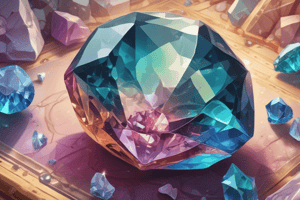Podcast
Questions and Answers
What is the purpose of cut-off adjustments in accounting?
What is the purpose of cut-off adjustments in accounting?
What journal entry is made for an accrued expense?
What journal entry is made for an accrued expense?
Which principle assumes that a company will continue its operations in the foreseeable future?
Which principle assumes that a company will continue its operations in the foreseeable future?
What does the historical cost principle dictate?
What does the historical cost principle dictate?
Signup and view all the answers
What is an example of accrued income?
What is an example of accrued income?
Signup and view all the answers
Which statement best describes prepaid expenses?
Which statement best describes prepaid expenses?
Signup and view all the answers
In general ledger accounting, what is the purpose of the sales journal?
In general ledger accounting, what is the purpose of the sales journal?
Signup and view all the answers
Which accounting principle relates to focusing on information that significantly impacts decision-making?
Which accounting principle relates to focusing on information that significantly impacts decision-making?
Signup and view all the answers
Study Notes
Importance of Cut-off in Accounting
- Cut-off ensures transactions are recorded in the correct period.
- This aligns with the principle of separating periods.
- Accurate financial statements reflect a business's real performance and position.
Types of Cut-off Adjustments
Accrued Expenses
- Expenses during the current period but not yet paid or invoiced.
- Example: unpaid December utility bills recorded as expenses for that year.
- Journal Entry:
- Debit: Expense account (e.g., Electricity)
- Credit: Accrued Liabilities (e.g., Suppliers, invoices not yet received)
Accrued Income
- Income earned in the current period but not yet invoiced or received.
- Example: services performed in December but billed in January
- Journal Entry:
- Debit: Accounts Receivable (from customers)
- Credit: Revenue account
Prepaid Expenses
- Payments made in advance for future services or goods.
- Example: annual insurance premium in December covering the next year.
- Journal Entry:
- Debit: Prepaid Expenses
- Credit: Cash/Bank
Prepaid Income
- Income received in advance for future services or goods
- Example: customer deposit in December for a January service
- Journal Entry:
- Debit: Cash/Bank
- Credit: Prepaid Income
Core Accounting Principles
Continuity of Operations
- Financial statements assume the company will continue operations.
Historical Cost
- Assets and liabilities are recorded at their original purchase price.
Prudency
- Anticipate potential losses, but not unrealized gains
Materiality
- Focus on information significantly impacting decision-making.
Period Independence
- Transactions are recorded in the period they occur, regardless of cash movement.
Key Documents in Financial Auditing
- General Ledger: Records all journal entries.
- Journals: Sales, purchase, cash, miscellaneous
- Balance Sheet: Snapshot of assets, liabilities, and equity.
- Income Statement: Summarizes revenues, expenses, and profit/loss.
Organization of Financial Records
- Accounting Software: Tracks journal entries and generates reports.
- Auxiliary Journals: Detail accounts (e.g., accounts receivable, payable).
- Ledger and Balance: Aggregated and classified accounts.
Common Adjustments for Next Period (N+1)
- Accrued expenses: Reversed when paid.
- Prepaid expenses: Expense when the period progresses.
- Accrued income: Recorded as income when invoiced.
- Prepaid income: Recognized as revenue when service/product is delivered
Example Exercise - Utility Bill
- Scenario: €500 utility bill for December received on January 5
- December Adjustment:
- Debit: Utilities Expense €500
- Credit: Accrued Liabilities €500
- January Reversal:
- Debit: Accrued Liabilities €500
- Credit: Cash/Bank €500
Studying That Suits You
Use AI to generate personalized quizzes and flashcards to suit your learning preferences.
Related Documents
Description
This quiz covers the importance of cut-off in accounting and the various types of cut-off adjustments, including accrued expenses, accrued income, and prepaid expenses. Understand how these concepts ensure accurate financial reporting and compliance with accounting principles.




